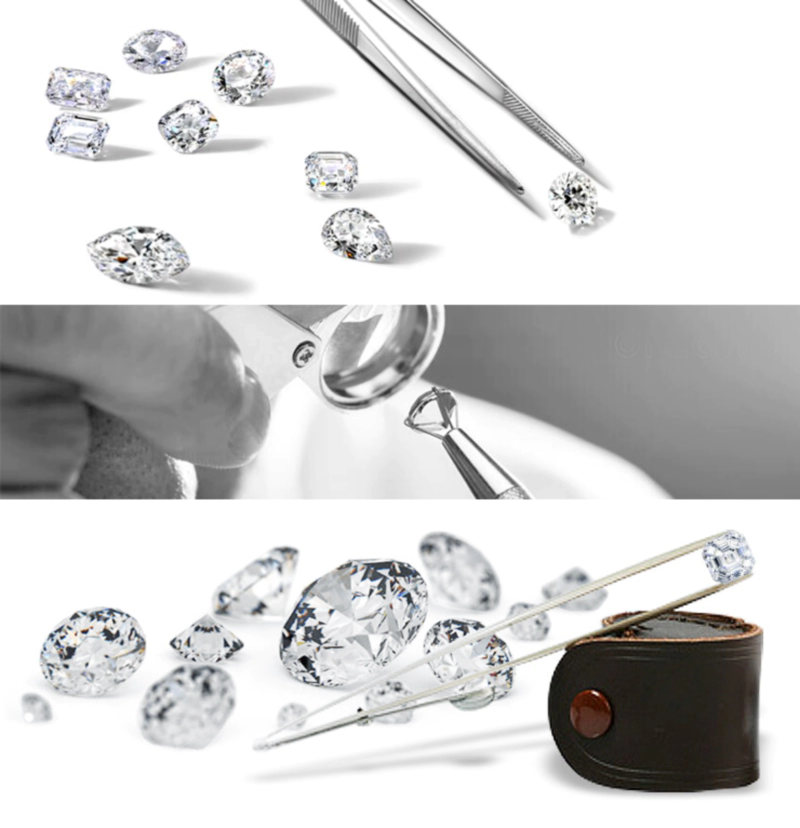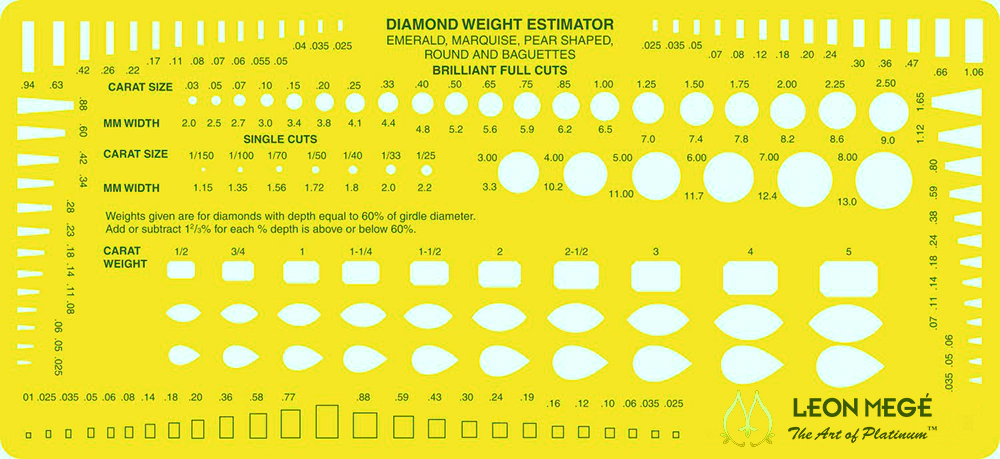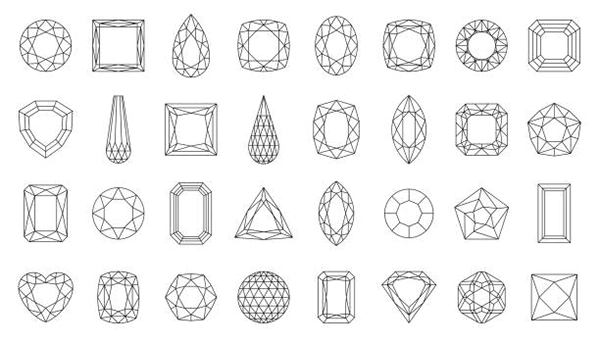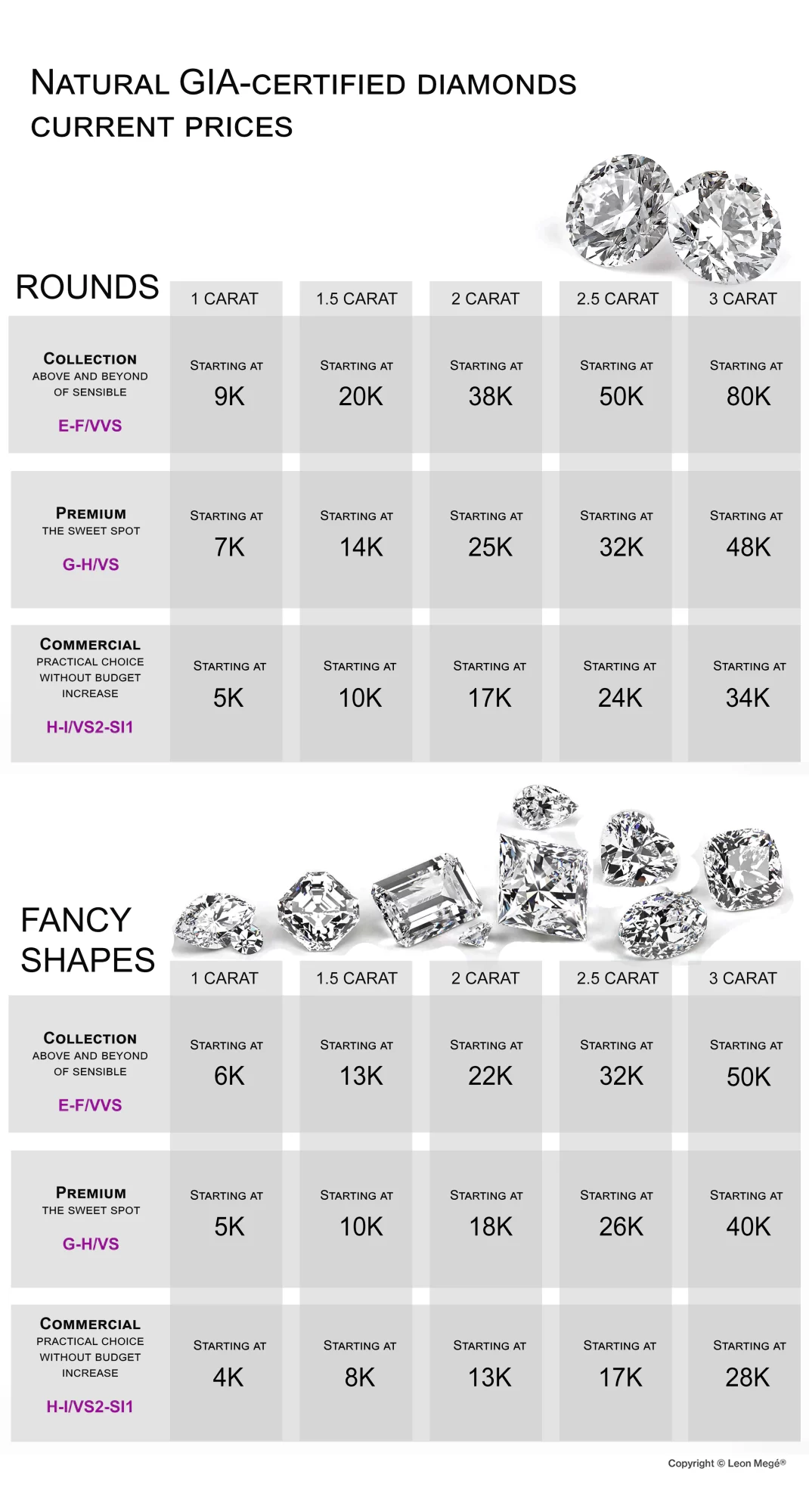Set a budget
Natural diamonds grow deep inside the earth, while lab-grown diamonds are synthesized at factories.
GIA created the 4Cs (Color, Clarity, Carat, Cut) system to help consumers shop for diamonds without a need for a gemological degree. There is a reason similar-looking diamonds are priced differently, and 4cs is a simple way to understand why. Using the 4C system, color, clarity, and weight can be dialed up or down to find a combination that fits the budget.
Often overlooked, the Fifth C is craftsmanship – the jeweler’s ability to take advantage of the stone’s unique features to enhance its presentation is crucial. Conversely, a poorly made ring can reduce even the most beautiful diamond to a dull pebble.

– Do you have a 3-carat diamond?
– Yes, we do.
– Top color, ideal cut?
– Yes. What is your budget?
– 500 dollars
– … You are in luck! We have a 3-carat flawless diamond, and it’s only $500!
– You are kidding!!!
– Yeah…. But you started it!
Realistic expectations
Be realistic with what size and grade diamond is affordable on your budget. Diamonds are an openly traded commodity, so the prices are uniform across the globe. You get what you pay for.
A diamond engagement ring indicates a social status but does not determine it. Spending more than you can afford to show off is not smart. There is always a possibility of an upgrade in the future. Without a microscope, most grades cannot be told apart except by what’s left in your bank account.
Select a diamond grade
Color and carat weight dramatically affect the price, while clarity and cut have a lesser effect. To find your target grade, first decide what combination of two parameters is most important to you:
- budget and size
- budget and grade
- size and grade
 What diamond size can you afford? Use our exclusive diamond affordability calculator to find out.
What diamond size can you afford? Use our exclusive diamond affordability calculator to find out.

Most popular grades
Tight Budget: J-K/SI-I –
Smart Choice H-I/ SI1+ (VS1+ for step-cuts)
Premium: F-G/VS+
Vanity: D-F/VVS+
Investment: D-E/IF-VVS1
Pick color

Diamond color grade significantly affects a diamond’s price because it reflects how rare the stone is. Colorless diamonds are rare but not necessarily the best-looking because a drop of warm tinge can bring a balanced and natural look. Some feel that D-E diamonds have a somewhat unnatural look, similar to cubic zirconia.
The sweet spot is the G-H color range with natural diamonds and E-F with lab-grown.
Pick clarity

Moderate inclusions are gifts of nature, providing a generous discount while being virtually undetectable. According to GIA, grades above SI2 are eye-clean. In reality, most SI grades are not eye-clean, meaning some people might be able to see the inclusions without magnification. “Eye-clean” is a subjective opinion that depends on eyesight, lighting conditions, depth perception, and even mental condition.
Eye-clean SI1 is a sweet spot for a brilliant cut. VS2 is the lowest recommended clarity grade for step-cut emeralds or Asscher diamonds because facet reflections do not mask inclusions well.

As the diamond weight increases, so does the price, but not incrementally like other commodities. At certain points, diamond prices jump exponentially, for example, at 1, 1.5, 2, 2.5, 3, etc., carat marks. For example, diamonds ranging from 1.00 to 1.49 carats are priced similarly per carat. But once the 1.5-carat magic number is reached, the diamond’s price per carat increases dramatically.
Choose Carat Size
Diamond size is a measure of weight expressed in carats, not carrots. Its physical dimensions do not necessarily correspond to its weight, particularly for fancy shapes.
Buying a diamond of a certain carat weight is driven by peer pressure and social status, but sacrificing the size for better quality is a good strategy. A low-grade diamond is a waste of money, regardless of its size.
A person’s height, body type, or the length of their fingers has nothing to do with a diamond size. However, the ring style and finger size must be considered when targeting a certain carat size.
Choose Cut
Diamond shape and diamond cut are two different things. The preferred diamond shape selection is based on personal taste; the most popular is a round brilliant. Diamond cut is the degree of artistry and precision in faceting execution.
Only round diamonds have GIA cut grade; fancy-shaped diamonds do not have a grade for a cut. A GIA “excellent” cut grade is essential for a diamond to guarantee its beauty and superb light return. Symmetry is the key to modern fancy-shaped diamond excellence but not antique cuts.

Diamond Beauty
One man's meat is another man's poison
Lucretius - Roman Poet
Diamonds bring happiness; otherwise, they would be worthless. The regret of buying a junky diamond lingers long after the joy of scoring a bargain is forgotten. A diamond grade is not a measure of a stone’s beauty but is a mere hint at its scarcity. Beauty is in the eye of the beholder. A perfectly symmetrical, completely void of color and inclusions diamond is not superior; it is just one of the countless variations. The measure of beauty depends on personal taste.
Diamond Trivia
- Diamonds are formed deep in the earth at depths between 87 to 118 miles underground.
- Diamond is the solid form of carbon, crystallized in a cubic structure.
- Diamonds come in every color, although some colors, such as green or red, are extremely rare.
- Every diamond in the market is millions or billions of years old. They existed long before dinosaurs roamed the earth.
- The largest diamond, called Cullinan, was discovered in South Africa in 1905. It was 3,106.75 carats and weighed more than 1.3 pounds.
- There are diamonds in space. Scientists have discovered distant planets and stars made almost entirely of diamonds. One of them, 55 Cancri e, is believed to be a one-third diamond.
- 80% of all diamonds are located in New York City.

